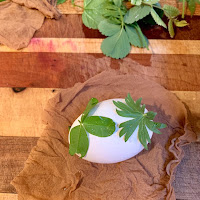Fabric Collage
Collage is a form of art which originated from France in the early 20th century, which means literally “gluing”. The word describes the composition of different materials affixed to a backing.
In this project, the students made their selections of fabrics of varying textures, designs and color and then arranged them to cover the entire picture plane. Though simple, planning and making their collages took the children out of their usual ‘box’ - and into a fun process of composition and designing with materials other than their everyday paint and crayons!
1st GRADE
Three-Dimensional Clouds
Three-Dimensional Clouds
This art project was correlated with the first grade science curriculum “weather unit”. After reading the story “Little Cloud” by Eric Carle, first grade students created a variety of different shaped clouds (i.e. sheep clouds, little clouds, big clouds, air plain clouds, cat clouds, etc.) The clouds were crafted out of large paper and stuffed with shredded newspaper to create a three-dimensional look.
2nd GRADE
Kandinsky Abstract Art: Painting to Music Fast and Slow
Kandinsky Abstract Art: Painting to Music Fast and Slow
One of the first modern abstract artists, Wassily Kandinsky (1866-1944), who was also an accomplished musician, hoped people would ‘hear’ his art, rather then appreciate it solely with their eyes.
In this project, the students were introduce to Kandinsky’s concept of painting not what the artist saw, but what he or she heard and felt. While listening to the rhythms of both fast and slow music, students were encouraged to mix new colors, overlap shapes and designs. They closed their eyes and let their brushes and pens move freely to capture the music they heard.
3rd GRADE
Cityscapes:
Cityscapes:
A Cityscape is the urban equivalent of a landscape. Students were introduced to the concept of cityscapes in the visual arts by looking at paintings, drawings, prints and photographs of different artists depicting an urban scene.
The visual concepts of the horizon line, foreground, middle ground, and background were introduced to the students. With tempera paint students painted a background, experimenting with brushes and sponges to create textures. Using a collection of recycled materials, such as: calendars, maps, packaging materials and wrapping paper, students designed their unique city skylines.
4th GRADE
4th GRADE
California Watercolor Books:
This lesson connects with the 4th grade studies on California. The 4th grade students experimented with four different watercolor techniques: sea salt, plastic wrap, wash with texture, and oil pastel resist. Students created an accordion fold book out of watercolor paper and practiced each technique on one page of the book. Students worked with simple bookbinding techniques to create a front and back cover for their books. On the back side of the accordion book, students painted a California landscape representing one of the four California regions (coast, mountains,desert, central valley). Students applied the watercolor techniques to the landscape. As a finishing touch students wrote a thoughtful quote/poem in their books. The quote informs the viewer about an idea, emotion,or connection to the landscape that cannot be seen.






















